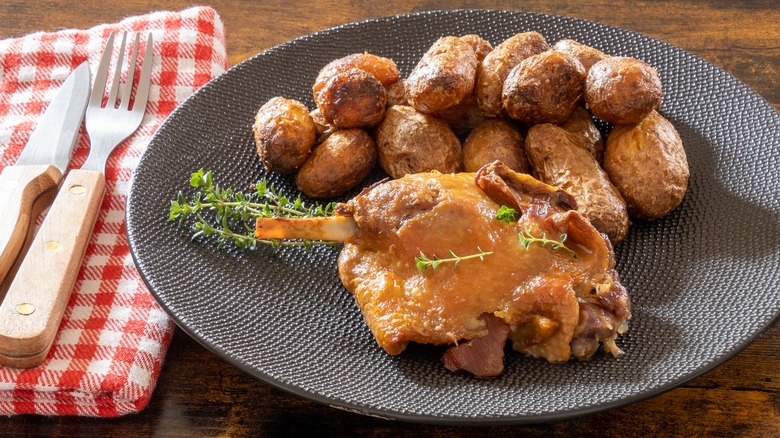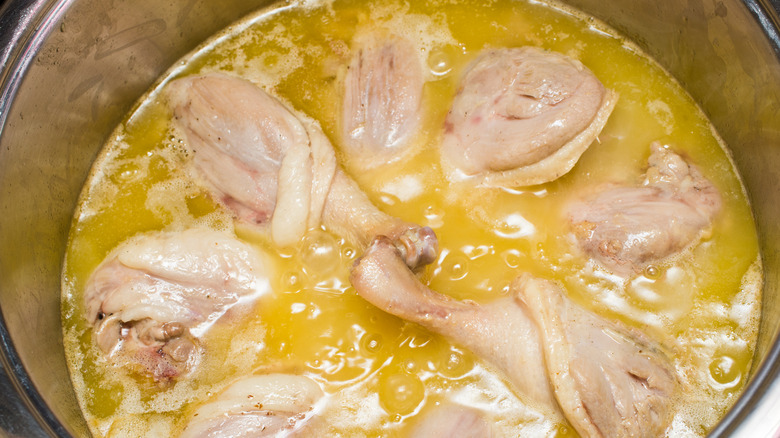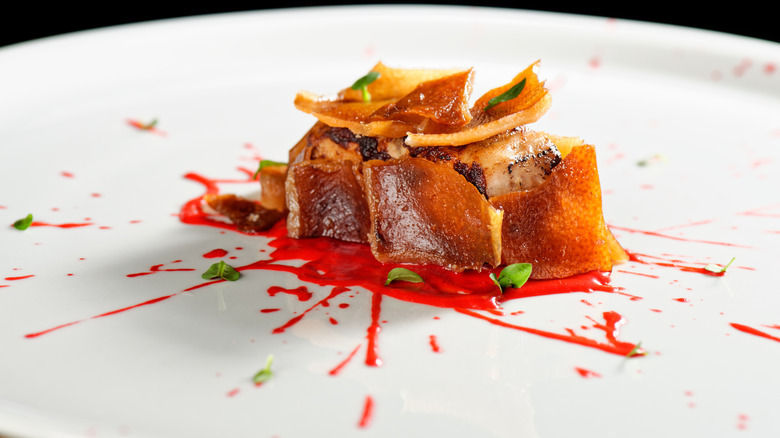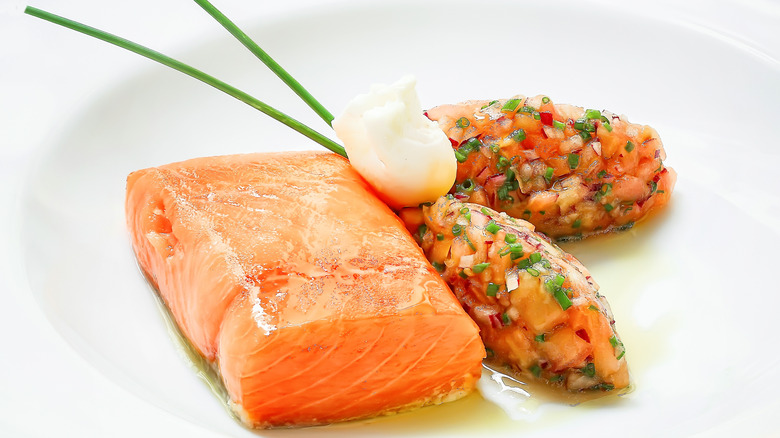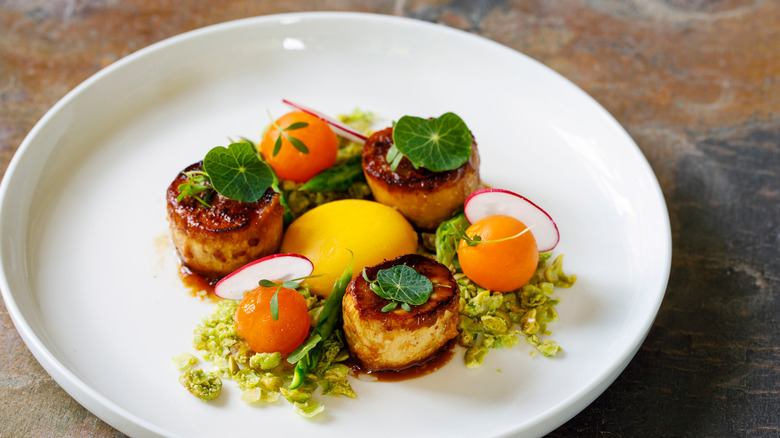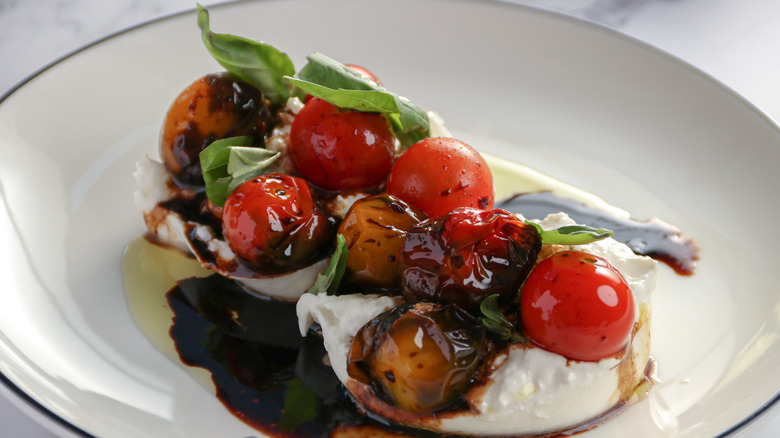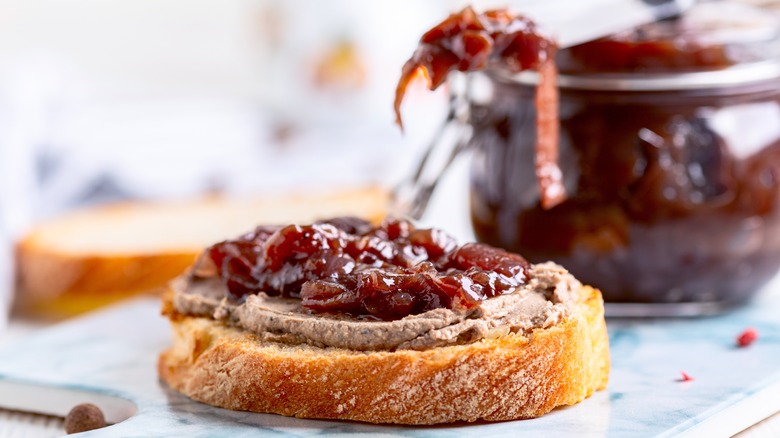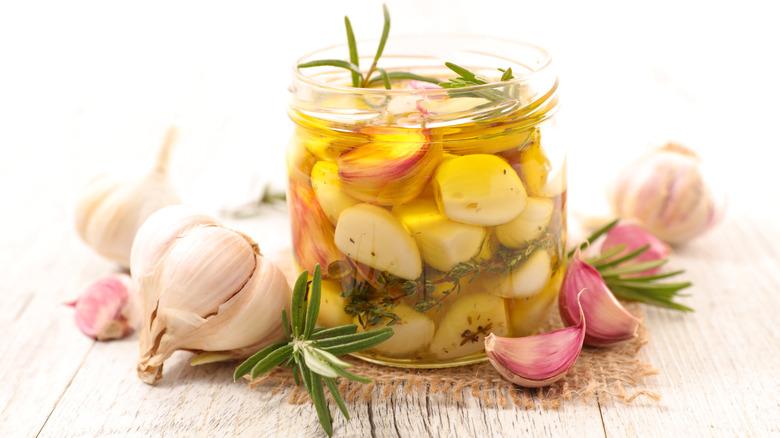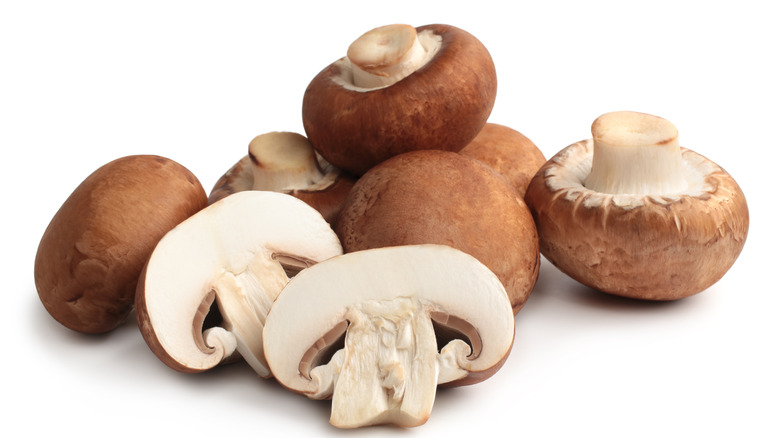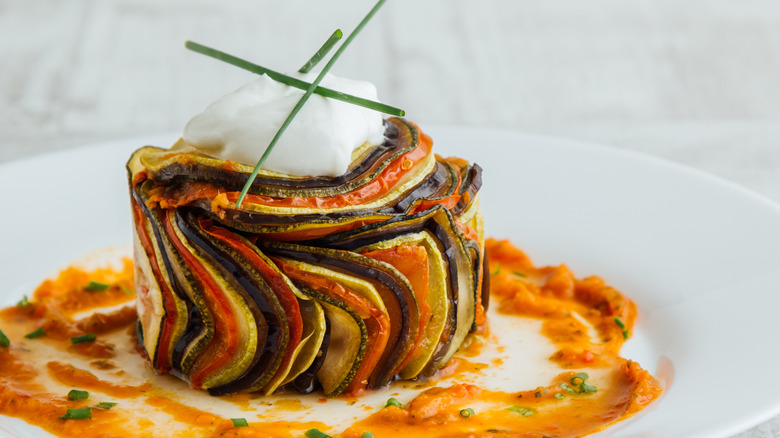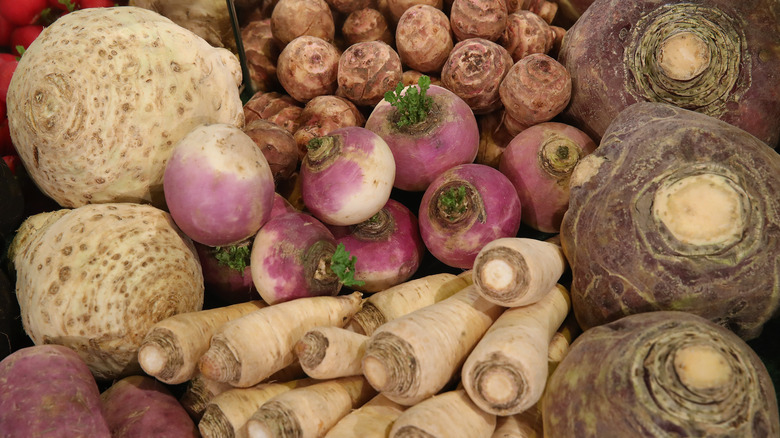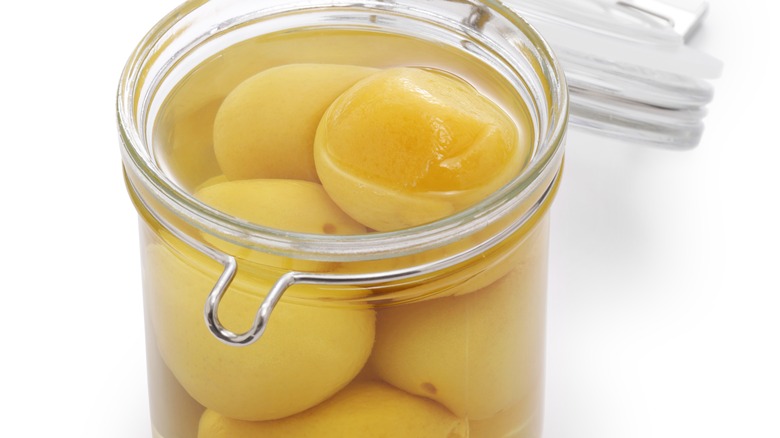11 Best Foods That Work Best For The Confit Process
There is something magical about confit. Perhaps it is the bit of time travel inherent in the process of preservation: dishes can remain delicious for days and weeks later — and some meat confit can last months. Confit as a process is an old one, dating back to the 15th century, according to Masterclass, when hunters came home with game birds and preserved the legs and wings by salting them and storing in fat. The basics of the French confit technique have broadened considerably from those origins.
Today, confit can describe any fatty piece of meat that has been salted and cooked slowly in a fat bath. Meat can be cooked in lard or in fat like olive oil for an easy substitution for duck fat confit. Vegetables and fruits can also be the star subjects of the confit treatment. Follow a few fundamental rules (we'll help you avoid some basic mistakes!) and you too can preserve and elevate the best of any season.
Go classic with duck confit
Duck confit is, of course, a French classic that brings you back to the origins of the process. The traditional duck confit recipe involves submerging salted duck legs in large amounts of duck fat and cooking them for about 2½ to 4 hours. There are other ways to achieve much the same result. For example, you could make a simple and satisfying duck confit using significantly less liquid when you render fat from the duck legs themselves.
Similarly, other types of poultry work well with the confit treatment. Just about any recipe that works for duck legs will work for goose legs. Of course, a goose can be somewhat difficult to source. Chicken is readily available and can also make an excellent chicken confit. While many chicken confit recipes call for the chicken meat to be simmered in duck fat to take the richness up a notch, we believe that schmaltz (as in rendered chicken fat) is one of the tastiest fats on the planet. While the term "confit" sounds fancy, the reality is that a confit chicken wings recipe makes, quite possibly, the most extraordinary version of the classic bar snack you've ever had!
Treat pork to the similar confit methods as duck
People who don't eat meat for religious reasons have long enjoyed some of the best slow-cooking techniques for meat without eating pork. Duck is an excellent substitute for pork. For example, the University of Washington reports that in the Middle Ages, Jews living in Spain who observed Kosher laws went so far as to make duck and goose "hams." Today, home chefs can apply confit methods to pork in classic and innovative dishes.
So, why not experiment with the slow-cooking confit techniques by rending pork in duck fat? That's just what restauranteur Thomas Chen has done at Tuome in New York City: a crisp-skinned pork confit made from shoulder meat that is cured and then cooked for 15 hours in duck fat. You can also confit pork in its own delicious juices. As New City points out, classic Mexican pork carnitas is pretty much pork confit since the meat is simmered in its own fat for hours.
Confit is a perfect way to bring the best out of fish
Many types of fish take well to the confit treatment. Indeed, it is fair to say that almost any type of fish could be right for confit. On the one hand, the confit technique is particularly effective for lean fish like cod because the technique adds fat — and a fatty fish might be overkill. It's that combination that means tuna confit is best with leaner varieties.
While it may be tempting to think of canned tuna as essentially the same thing as a confit made of fresh tuna, the reality is that your level of control makes all the difference. The better the cut of tuna and oil, the better the result will be.
That is not to say that fatty fish like salmon do not take well to the confit technique, as famed British chef Heston Blumenthal has shown. Poach salmon in olive oil in a jar by submerging and cooking in a hot water bath. The result is a flakey and moist salmon. Try pairing that salmon confit with herbs, nuts, and spices like sumac.
Confit egg yolks
It may be easy to think about confit as a technique fit mostly for fine dining restaurants and easier still to think of something like confit egg yolks as exotic. But, there is no reason you cannot play with something like that in your own kitchen. After all, what's wrong with a little fine dining at home, especially when it is surprisingly easy?
Egg yolks poached in olive oil really are delicious (and the same thing as confit cooking). Beyond that, they might be even easier to make than conventional eggs poached in water. To separate, you can crack the eggs over your upraised palm, let the whites run through your fingers, and add only the yolks to the poaching oil.
All you need to confit egg yolks is a heat source, a thermometer, a saucepan, eggs, and olive oil. Remember to carefully drop the yolks into the pan, and make sure they are fully submerged. Try popping one on top of a pasta dish, or toast a bagel, cover it with smoked salmon, and top the salmon with a confit egg yolk.
Tomato confit is an Italian classic
There may be no clearer example of the confit process as a way of preserving the bounty of the season than with tomato confit. It can be made with big beefsteak tomatoes or little cherry tomatoes. What tomato confit also shows, though, is that while it began as a preservation technique it is still here in large part because it is just so delicious.
Our favorite way to make tomato confit is to combine cherry tomatoes, garlic, and olive oil in a small saucepan and bring it to a boil over medium heat. You'll want to simmer until the tomatoes just start to split. Or you could make it like the viral TikTok confit method by slow-cooking in the oven. Whichever way you choose to go about making your tomato confit, you could use it on top of bruschetta or grilled vegetables. Tomato confit is a natural accompaniment to pasta. In our view, however, the highest use of it is to pop a confit cherry tomato on top of mushroom risotto.
Onion confit is even more flavorful
Onion confit (aka onion jam) is thin, half-moon slices of onion simmered slowly in fat with salt, pepper, sugar, and, sometimes, wine or vinegar. The cooked onions begin to turn golden, lose their texture, and approach the consistency of a jam. You can make onion confit with white, yellow, or red onions. The difference is less one of flavor than it is aesthetic.
While onion confit has its feet planted in the savory world, the secret to its versatility as an ingredient lies in the inherent sweetness of the onion itself. You can add onion confit to a burger. You can use it to top crostini. You can use your onion confit as a garnish on roasted meats, add it to sandwiches, or as a starring element of a charcuterie board.
Close relatives of the onion, like shallots, and leeks also benefit from being transformed by simmering oil. Just 1½ hours in the oven in olive oil yields a shallot confit recipe that can be used in nearly innumerable ways, including the incredibly flavorful shallot oil! Chef Dominique Crenn confits leeks in a vinaigrette in as little as half an hour. Wild leeks (aka ramps confit) make an excellent garnish.
Garlic confit is in a class of its own
Garlic may be the most versatile of the members of the allium family. A garlic confit recipe is almost certainly the most useful and versatile confit in that family. Making garlic confit is also remarkably simple. There are more ways to use garlic confit than you could shake a stick at. Whisk some garlic confit into a salad dressing like a red wine vinaigrette. Or, since garlic is a classic ingredient in marinara sauce, garlic confit could easily contribute additional richness. There may be no better way to upgrade mashed potatoes than to add some garlic confit. Our favorite way of using garlic confit, though, may indeed be one of the simplest for garlic bread! Just add some garlic confit to the raw garlic and salt, slather it over the bread, and bake away.
But, there is one very important (and very easy) precaution to take with your garlic confit to avoid the danger of an actually life-threatening illness: refrigerate the garlic confit, as soon as it cools down, in an airtight jar. Failing to take this precaution could be a literally fatal mistake when making garlic confit because it can lead to botulism.
Mushroom confit is remarkably versatile
While confit works well with many vegetables, there is one set of relatively humble options that are truly elevated by a long, slow simmer in fat: mushrooms. It's not that mushrooms are not tasty in their raw state, but rather that the confit treatment enhances their umami properties. While you could confit mushrooms in any fat, there may be no better choice than butter. Mushrooms love butter because it brings out their richness, is appropriate for vegetarians, and helps create caramelization. For many of the same reasons butter works for sautéed mushrooms, it works brilliantly for mushroom confit.
But, while it is almost a cliché that French cuisine loves its butter, the reality is that when you go to the south of France it is olive oil that's king, as Boots for Breakfast points out. That's also true for a mushroom confit made with olive oil.
Confit makes the eggplant sing
Eggplant, it seems, is the answer to the critical question: What vegetable do kids hate the most? According to a 2011 study, over half of the kids who did not like vegetables identified eggplant as their least favorite, per Japan Today. That survey came even after the blockbuster success of a movie featuring an adorable rat named for one of the world's most famous eggplant dishes: ratatouille.
Never mind that the dish in "Ratatouille" the movie — created by legendary Chef Thomas Keller no less — is not actually ratatouille. Rather it is Keller's more precise, elegant, and upscale variation of confit byaldi, itself an upscale variation of the classic ratatouille recipe featuring the same ingredients. But, Keller's confit byaldi recipe is far from the only way eggplant can star in a confit. While a ratatouille tian recipe is spiraled like the one in the movie, it is a bit more comfort food than fine dining.
Elevate humble root vegetables with confit
Perhaps one of the least obvious classes of vegetables to gain the confit technique is root vegetables. The secret is using plenty of oil. Indeed, you should probably err on the side of using more rather than less or even an excessive amount of oil rather than just enough. Doing otherwise is likely to simply be a mistake.
Much like the movie "Ratatouille" may have put eggplant confit on the map, so "The Menu" might do the same for potato confit. That preparation features in one of the movie's signature dishes: The Mess. While the dish may not be one you can actually order on any menu, Andrew Zimmern offers a spiral cord dish that certainly seems to invoke the scene of culinary horror. And potato confit is hardly the only root vegetable confit out there. We are particular fans of beet confit.
The thing that makes root vegetables such counterintuitively good candidates for the confit treatment is the very starchy quality that might make them seem unlikely prospects. Take, for example, parsnip confit. Sure, who would think something so seemingly puritan and hard would become as luscious as a confit? But, it is precisely the starch that allows you to make a silky purée after taking a warm bath in oil! Much the same works with carrot confit.
Don't sleep on confits in the world of fruits
While vegetable confits may not seem counterintuitive, fruit confits seem more so. The idea of simmering fresh fruit in a bunch of oil does not sound delicious. That, perhaps, is one of the key reasons the fruit is preserved in sugar syrup, not oil.
The reality is that you have probably tasted fruit confits many times in your life. Have you ever had a fruit preserve? If so, then you've had a fruit confit. What about a jam? That is a fruit confit, too. Jellies, marmalades, fruit curds, fruit spreads, candied fruit, and even fruit butter are all forms of fruit confit. One popular fruit confit is lemon confit. It may be sweet, but it can be used in savory and sweet applications. One of the most interesting savory uses is a lemon confit vinaigrette that would be a welcome addition to just about any salad.
Even the classic cranberry sauce on your Thanksgiving table is a form of a fruit confit. Take that to the next level, though, and make a simple cranberry confit by simmering whole cranberries in sugar, red wine, vinegar, and orange juice for an hour. The result will be a "cranberry sauce" that looks like a bunch of red pearls.
